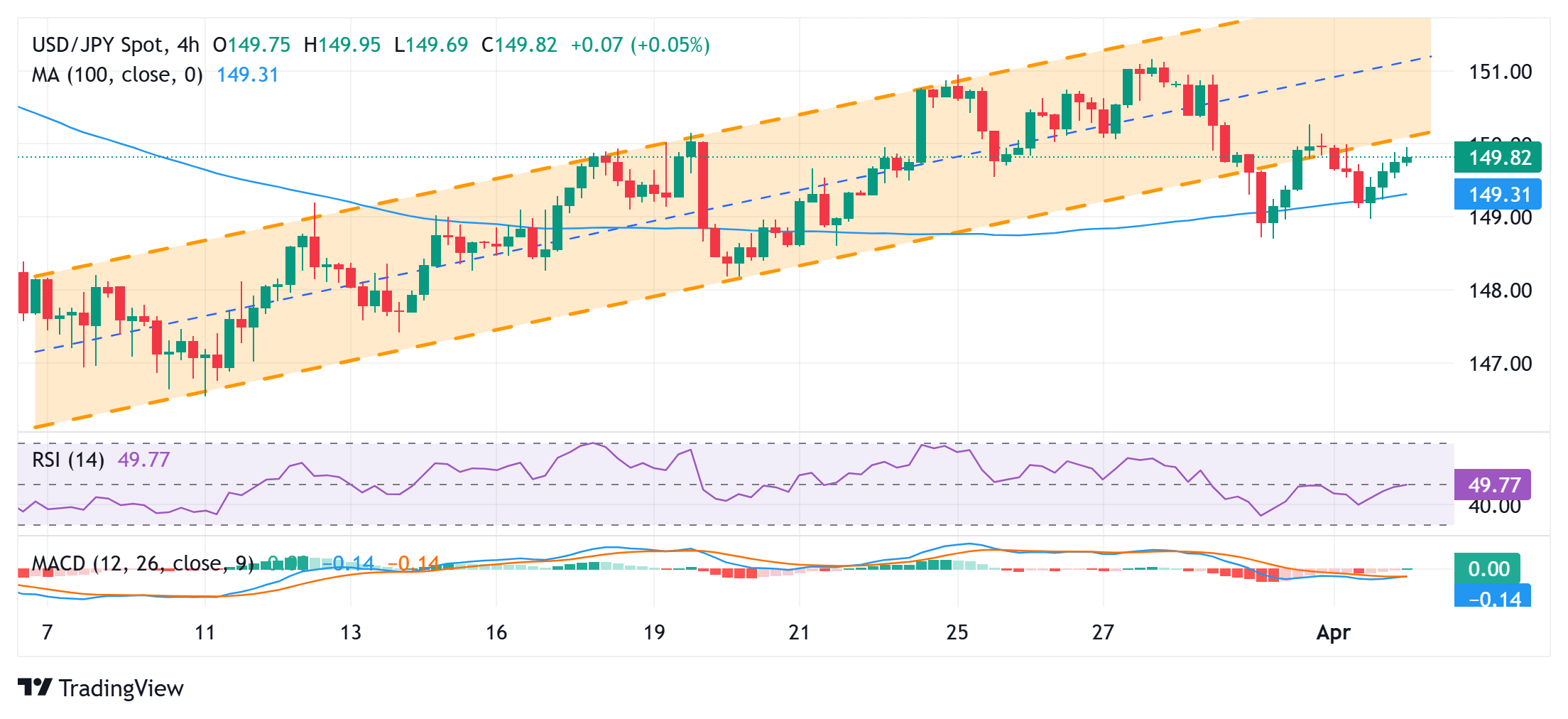-
The Japanese Yen edges lower amid concerns that Trump’s tariffs could impact Japan’s industries.
-
Diverging BoJ-Fed policy expectations may help limit further losses for the lower-yielding JPY.
-
Traders may hold back from making aggressive moves ahead of Trump’s tariff announcement.
The Japanese Yen (JPY) remains under pressure heading into the European session on Wednesday amid speculation that a tariff-induced economic slowdown could compel the Bank of Japan (BoJ) to maintain its current policy stance. Additionally, a broadly positive sentiment in Asian equity markets further weighs on the safe-haven JPY. This, coupled with a modest uptick in the US Dollar (USD), provides support to the USD/JPY pair.
However, expectations that the Bank of Japan will continue its gradual rate hikes due to persistent inflationary pressures in Japan help limit JPY losses. Meanwhile, growing bets that the Federal Reserve (Fed) will soon resume its rate-cutting cycle deter aggressive USD bullish positioning. Furthermore, the divergence in BoJ-Fed monetary policy expectations offers support to the lower-yielding JPY, preventing the USD/JPY pair from making a decisive move above the key 150.00 psychological level.
Japanese Yen sellers remain cautious amid BoJ rate hike prospects
- Asian equity markets mirrored Wall Street’s overnight gains as investors awaited US President Donald Trump’s announcement on reciprocal tariffs, dampening demand for the safe-haven Japanese Yen.
- Trump signaled on Sunday that the new levies would be broadly applied rather than targeted at a select group of countries with significant trade imbalances, dashing hopes of a more measured approach. Concerns that these tariffs could severely impact Japan’s key industries have led investors to temper expectations of an accelerated BoJ rate hike trajectory.
- Nevertheless, strong macroeconomic data, including Tokyo’s robust consumer inflation figures released last Friday, keeps the door open for further BoJ rate hikes, helping to curb deeper JPY losses. Meanwhile, the Federal Reserve finds itself in a precarious position as rising inflation and slowing business activity fuel fears of stagflation.
- These concerns were exacerbated by data showing the first contraction in the US manufacturing sector in three months, alongside factory-gate inflation hitting its highest level in nearly three years. The ISM Manufacturing Purchasing Managers Index (PMI) declined to 49 from 50.3 in February, while the Employment Index reflected accelerating job losses in the sector. Additionally, the Job Openings and Labor Turnover Survey (JOLTS) revealed a decline in job openings to 7.56 million in February from 7.76 million in January.
- Market participants currently anticipate that the Fed will lower interest rates by 80 basis points by year-end, limiting the USD’s appeal. The narrowing policy gap between the BoJ and the Fed could further restrict JPY losses and keep the USD/JPY pair from climbing significantly.
- Traders now turn their attention to Wednesday's US economic docket, featuring the ADP report on private-sector employment and Factory Orders, for further cues ahead of Trump's tariff announcement.
USD/JPY struggles to reclaim 150.00; upside potential remains uncertain

From a technical standpoint, the USD/JPY pair has displayed resilience below the 100-period Simple Moving Average (SMA) since the start of the week. While the subsequent rebound may favor bullish traders, neutral oscillators suggest caution. Furthermore, a recent breakdown below a multi-week ascending channel calls for confirmation of sustained buying before considering any significant upside.
The weekly high near the 150.25 mark acts as an immediate resistance level. A decisive break above this could drive the USD/JPY pair towards the 150.75-150.80 region, followed by the 151.00 level. Further gains may see the pair testing the March swing high around 151.30 and the 200-day SMA near 151.60, potentially extending towards the 152.00 level and the 152.45-152.50 region, with an eye on the 100-day SMA near the 153.00 threshold.
On the downside, the 100-period SMA on the 4-hour chart, currently around 149.30-149.25, followed by the 149.00 handle and the weekly swing low of 148.70, offers immediate support. A sustained break below these levels could trigger fresh bearish momentum, making the pair vulnerable to resuming its broader three-month downtrend.





